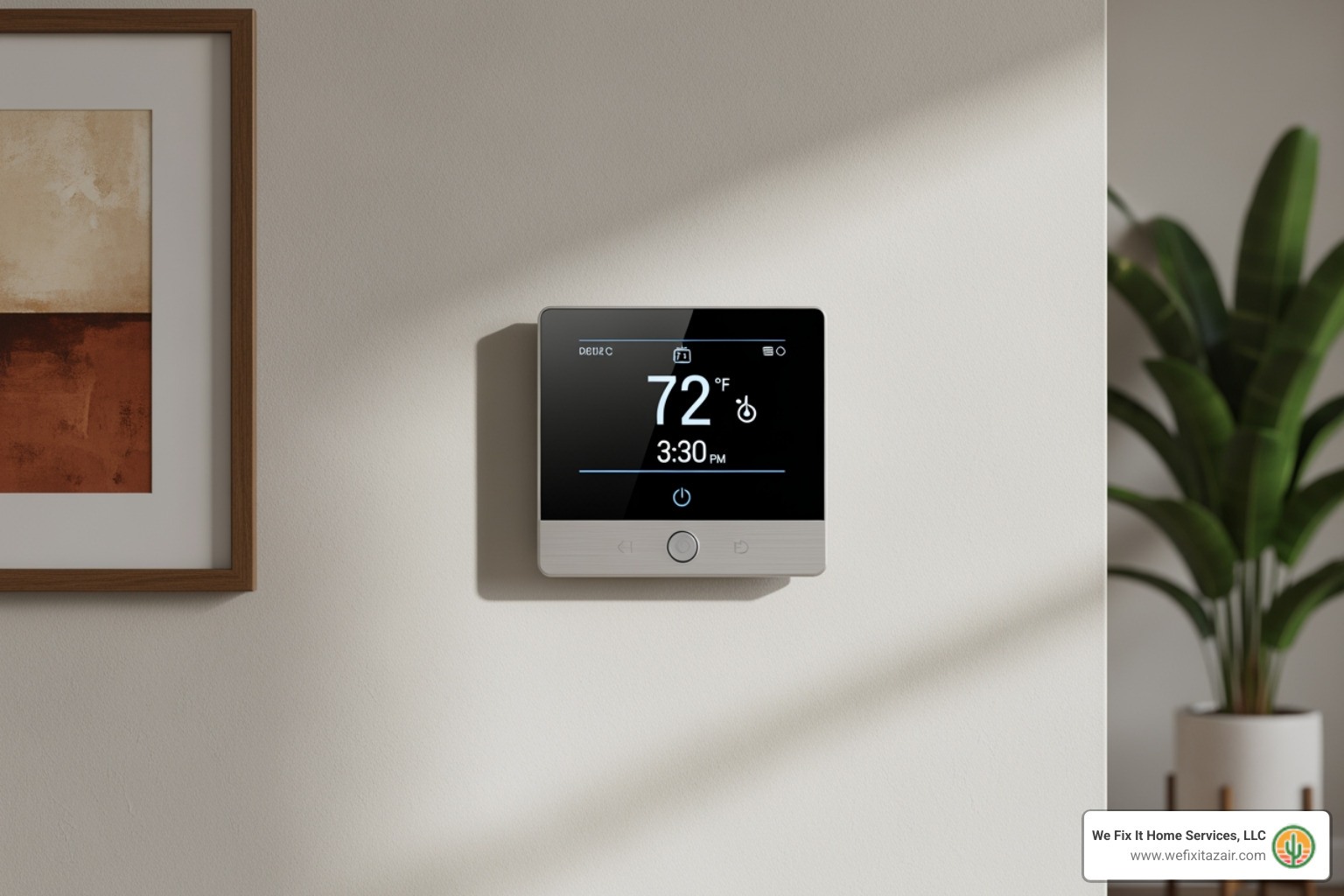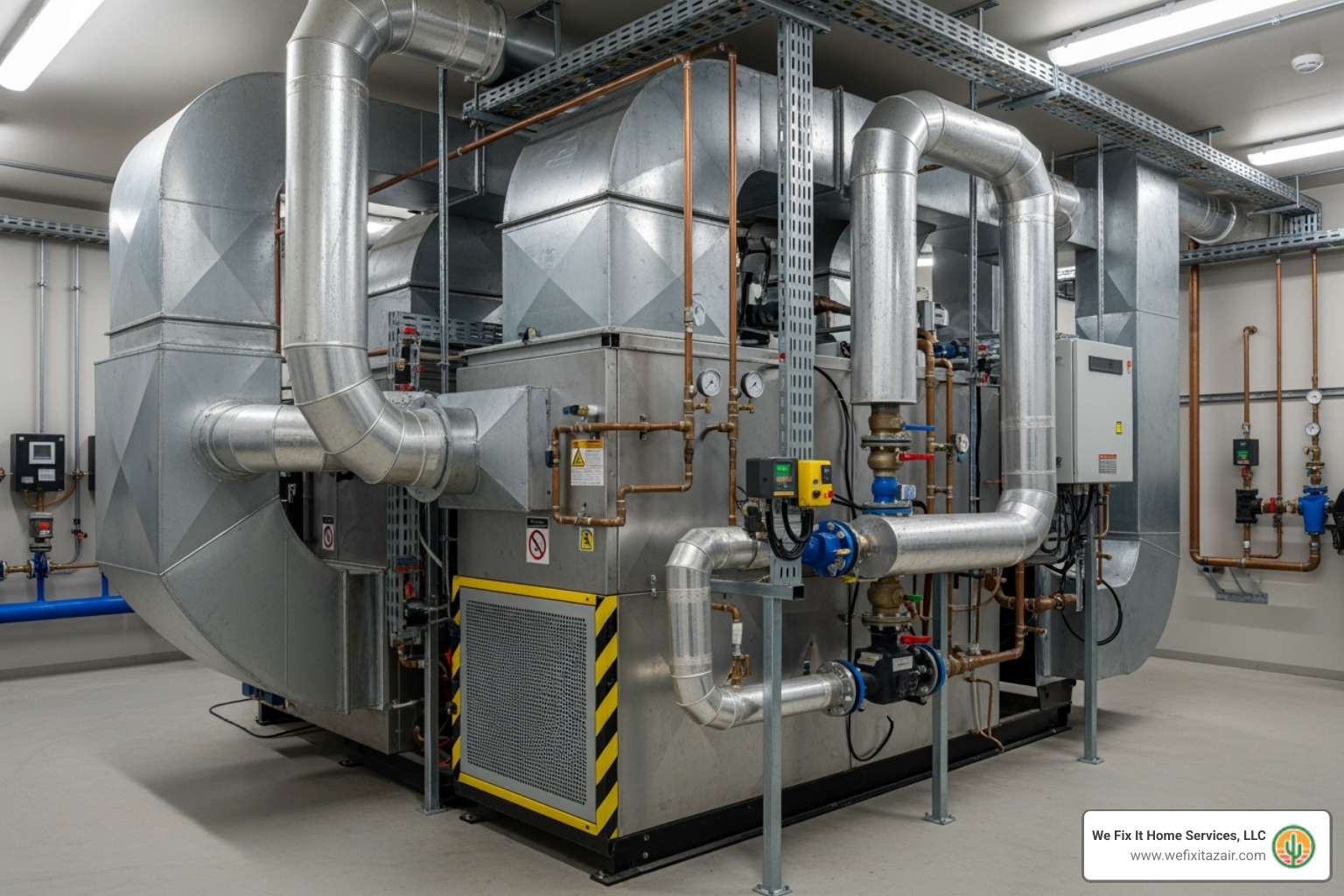Beyond the Basics: A Deep Dive into Your Furnace's Vital Components

Why Your Furnace Heat Exchanger is the Most Critical Component in Your Home
A furnace heat exchanger is the metal component inside your furnace that transfers heat from burning fuel to the air circulating through your home. Its most critical role is safety: it keeps dangerous combustion gases, like carbon monoxide, separate from the air you breathe. Understanding this component is key, as a functioning heat exchanger provides efficient warmth, while a damaged one can pose a serious health risk.
The process is a form of indirect heat transfer. Hot combustion gases flow through the heat exchanger's metal tubes, heating them. Your furnace blower then pushes air from your home over the hot exterior of these tubes. This warms the air before it circulates through your vents, while the harmful exhaust gases are safely vented outside through a flue pipe.
All furnaces have a primary heat exchanger, but high-efficiency models also include a secondary heat exchanger to capture more heat, boosting efficiency to 90% or higher. With a typical lifespan of 15-20 years, it's important to watch for warning signs like strange odors, unusual sounds, or CO detector alerts.

Understanding Your Furnace Heat Exchanger: Function and Types
Every gas furnace contains a furnace heat exchanger, a component vital for both heating and safety. It's a series of metal tubes or coils that transfers heat to your home's air without allowing dangerous exhaust fumes to mix with it. A heat exchanger is a device that moves heat between two fluids, and in your furnace, it's designed specifically for home comfort. Proper furnace setup is key to the heat exchanger's longevity. Learn more about Dependable Furnace Installation for Comfort.
How a Heat Exchanger Works
The heating process begins in the combustion chamber, where fuel ignites to create hot flue gases. These gases flow into the heat exchanger, heating its metal surfaces. Simultaneously, the furnace's blower motor pulls cool air from your home and pushes it over the hot exterior of the heat exchanger. This indirect heat transfer warms the air without it ever contacting the flames or exhaust.
Once heated, the air is distributed through your ducts. The now-cooler combustion gases are safely vented outside through the flue vent. This complete heating cycle ensures your home stays warm and your indoor air remains safe.
Primary vs. Secondary Heat Exchangers
Furnaces have one or two heat exchangers, depending on their efficiency.
Primary Heat Exchanger: Every gas furnace has a primary heat exchanger located near the burners. It performs the initial heat transfer. In standard-efficiency furnaces (70-80% AFUE), this is the only heat exchanger, and some heat is lost with the exhaust.
Secondary Heat Exchanger: Found in high-efficiency condensing furnaces (90%+ AFUE), this component captures additional heat from the exhaust gases. The gases cool to the point that water vapor condenses, releasing extra latent heat. This recovered heat is used to further warm your home's air, improving efficiency and lowering energy bills. Because the condensate can be corrosive, secondary heat exchangers are typically made of durable materials like stainless steel.
Upgrading to a high-efficiency system can lead to significant savings. Our experts are skilled at installing these modern furnaces. Find out more about our Furnace Installation San Tan Valley AZ services. For more on this technology, read about the All About Furnace Secondary Heat Exchanger.
The Critical Signs of a Failing Heat Exchanger
A damaged furnace heat exchanger is a serious safety concern because it can allow dangerous combustion byproducts, especially carbon monoxide (CO), to enter your home's air. Failure is often caused by metal fatigue from constant expansion and contraction. Other causes include corrosion, soot buildup from incomplete combustion, and overheating due to restricted airflow. When cracks form, the barrier protecting your indoor air is compromised. For more insights, see our guide to Furnace Repair Issues & Solutions.
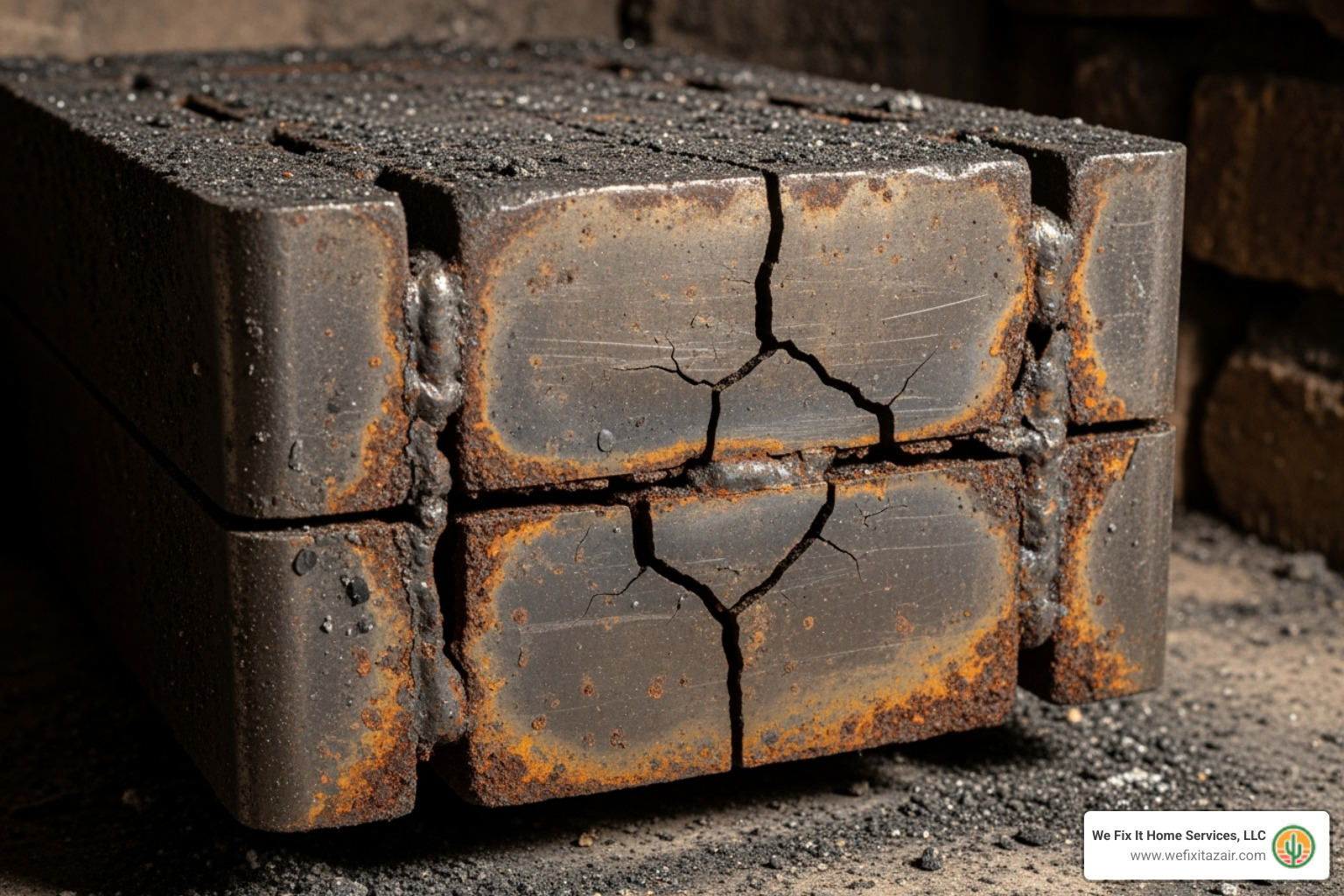
Signs of a Damaged Furnace Heat Exchanger
Only a professional can confirm a crack, but homeowners should call for an inspection if they notice these signs:
- Flickering or Yellow Burner Flame: A healthy flame is steady and blue. A yellow, dancing, or "rolling" flame indicates a combustion problem, possibly from a crack.
- Unusual Smells: Odors like formaldehyde or metal near vents can signal leaking combustion gases.
- Popping or Rattling Sounds: Loud noises when the furnace starts or stops may be caused by cracked metal expanding and contracting.
- Visible Cracks or Soot: You may see soot buildup, rust, or visible cracks on the components.
- Water Pooling Around the Furnace: In high-efficiency units, this can indicate a problem with the secondary heat exchanger or condensate drain.
- Reduced Heating Performance: A compromised heat exchanger can lead to poor heating, cold spots, or frequent on-off cycling.
The Dangers of Carbon Monoxide
The most severe risk of a damaged furnace heat exchanger is carbon monoxide (CO) poisoning. CO is an odorless, colorless, and tasteless gas that can be fatal. It displaces oxygen in the bloodstream, leading to cellular suffocation.
Symptoms of CO poisoning mimic the flu and include headaches, dizziness, nausea, and confusion. Prolonged exposure can cause loss of consciousness, brain damage, or death. This is why functional carbon monoxide detectors on every level of your home are non-negotiable. Test them regularly and replace them according to manufacturer guidelines. While detectors provide a warning, they don't fix the source. For comprehensive safety, consider our Home Air Purification System San Tan Valley AZ.
What Causes a Furnace Heat Exchanger to Fail?
Several factors can lead to premature failure:
- Metal Fatigue: The constant cycle of heating and cooling weakens the metal over time, leading to cracks.
- Overheating & Restricted Airflow: A dirty or clogged air filter or blocked vents prevent air from cooling the heat exchanger efficiently. This excess heat accelerates metal fatigue.
- Improper Furnace Sizing: An oversized furnace will "short cycle" (turn on and off too frequently), while an undersized one runs constantly. Both scenarios cause excessive stress.
- Age and Wear: Most heat exchangers last 10-20 years. As a furnace ages, its components naturally degrade, making failure more likely. Learn more about Top Furnace Repair Issues.
Longevity and Maintenance: Protecting Your System
A furnace heat exchanger is built to last, with a typical lifespan of 15 to 20 years when properly maintained. However, this lifespan is not guaranteed and depends heavily on regular care. Many manufacturers offer extended warranties, underscoring the component's designed durability. Consistent maintenance is the key to preventing premature failure and ensuring safe operation. Learn more about the Importance of Gas Furnace Maintenance.
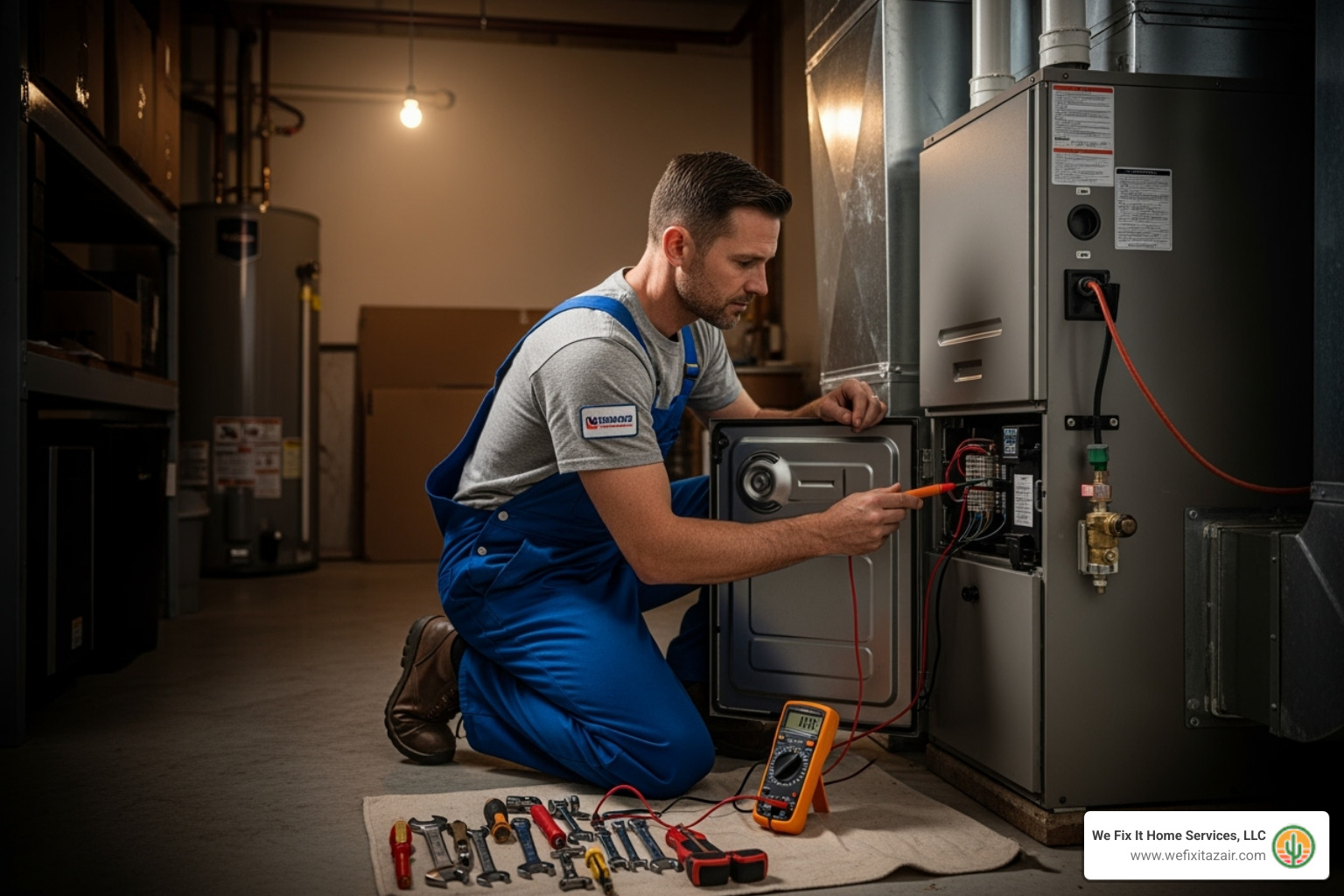
The Role of Regular Furnace Maintenance
Annual professional maintenance is your best defense against heat exchanger failure. During a tune-up, NATE-certified technicians perform critical safety and performance checks:
- Professional Inspection: We use specialized tools like borescope cameras to inspect the interior of the heat exchanger for hairline cracks that are invisible to the naked eye.
- Combustion Analysis: We use equipment to measure combustion gases and check for liftd carbon monoxide levels, which can indicate a crack.
- Cleaning: Removing soot and debris from burners and heat exchanger surfaces prevents hot spots that can stress the metal and lead to cracks. It also ensures proper airflow to prevent overheating.
This proactive care is crucial for extending your system's lifespan. For comprehensive service, explore our Furnace Maintenance San Tan Valley AZ plans.
Homeowner Detection and Prevention
Between professional visits, homeowners can take several steps to protect their system:
- Change Air Filters Regularly: A clogged filter restricts airflow, causing the furnace to overheat. Check filters monthly and replace them every 1-3 months.
- Keep Vents Clear: Ensure furniture, rugs, and other items are not blocking supply or return vents to maintain proper circulation.
- Monitor CO Detectors: Install and regularly test carbon monoxide detectors. If an alarm sounds, evacuate immediately and call for help.
- Watch for Warning Signs: Pay attention to strange smells, unusual noises, or a yellow burner flame. These are early indicators of a problem.
- Schedule Annual Tune-Ups: Book a professional inspection each fall before the heating season begins.
If your furnace isn't heating properly, it could be a sign of a larger issue. Refer to our guide on Furnace Not Blowing Hot Air: Guide to Troubleshooting Common Furnace Issues.
Repair or Replace? Making the Right Call
Finding you have a cracked furnace heat exchanger is serious, but you have options. The main decision is whether to replace only the heat exchanger or the entire furnace. Factors like your furnace's age, warranty status, and overall condition will guide the best choice for your home and budget.
Replacing a heat exchanger is a labor-intensive job, as the component is located deep inside the unit. This makes it a significant investment, which is why it's important to weigh your options carefully. For more guidance, see our article on When to Opt for a Furnace Replacement.
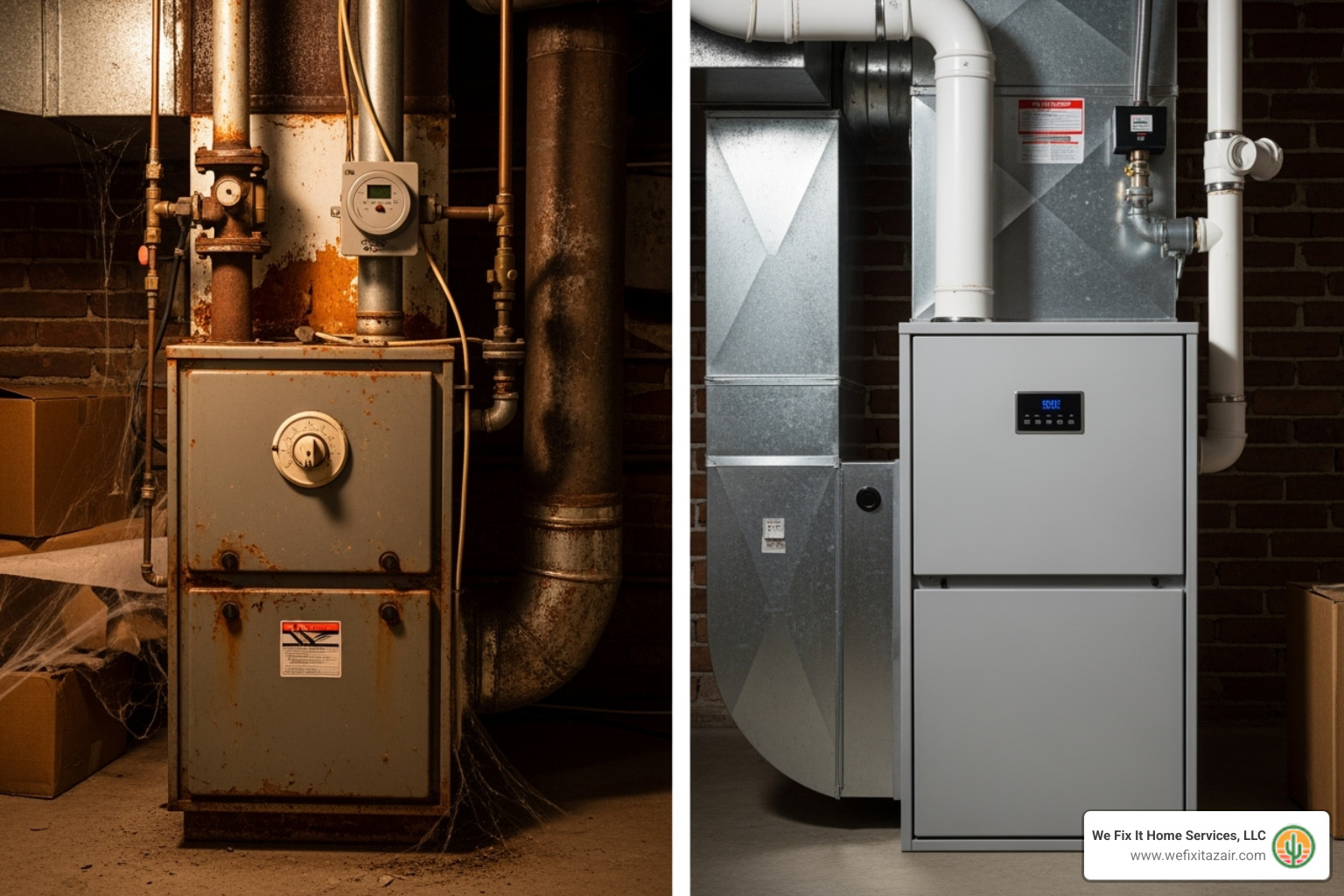
When to Consider Repair (Part Replacement)
Replacing just the furnace heat exchanger can be a sensible option if:
- The Furnace is Young: If your unit is under 10 years old and otherwise in good condition, a replacement part may be the most economical choice.
- The Part is Under Warranty: Many manufacturers offer long-term warranties on heat exchangers. If yours is covered, you will only be responsible for labor costs, making the repair much more affordable. Proof of annual maintenance is often required.
If these conditions apply, our team can provide expert Furnace Repair San Tan Valley AZ services.
When to Consider Full Furnace Replacement
In many cases, a cracked heat exchanger is a sign that it's time for a new furnace. Replacement is often the smarter long-term investment when:
- The Furnace is Old: For units over 10-15 years old, investing in a major repair is often unwise, as other components are likely to fail soon.
- The Warranty has Expired: Without a warranty, the cost of the part and labor can approach or exceed the price of a new, more efficient furnace.
- The System is Unreliable: If your furnace has required frequent repairs, a new system offers a fresh start with a comprehensive warranty.
- You Want Better Efficiency: Modern furnaces are far more energy-efficient. Upgrading can lead to significant long-term savings on utility bills, helping to offset the initial investment.
For more on this topic, explore the Furnace Replacement: Top Reasons.
Frequently Asked Questions about Furnace Heat Exchangers
Can a cracked heat exchanger be repaired?
No. A cracked furnace heat exchanger cannot be safely repaired. Welding a crack is not a viable solution, as the intense heating and cooling cycles would cause the weld to fail quickly, reintroducing the risk of a carbon monoxide leak. Industry safety standards are clear: a cracked heat exchanger must be replaced, either by installing a new component or a new furnace.
How does a technician confirm a heat exchanger is cracked?
NATE-certified technicians use several methods to diagnose a cracked furnace heat exchanger:
- Visual Inspection: Looking for obvious cracks, rust, or soot buildup.
- Borescope Cameras: Using flexible cameras to inspect hard-to-see internal surfaces.
- Combustion Analysis: Measuring gases in the flue vent. Liftd carbon monoxide levels are a strong indicator of a crack.
- Flame Observation: Checking for an unsteady or "rolling" flame, which suggests combustion gases are not being properly contained.
If we find a crack, we will show you the evidence so you can make an informed decision.
How long does a furnace heat exchanger typically last?
The average lifespan of a furnace heat exchanger is 10 to 20 years. However, this can vary significantly. Longevity is directly impacted by factors like consistent professional maintenance, proper airflow (i.e., clean filters and clear vents), and correct initial installation. While metal fatigue from heating cycles is inevitable, regular care is the best way to maximize the component's life.
Conclusion
Your furnace heat exchanger is the heart of your heating system and a critical safety device. It provides warmth while protecting your family from dangerous combustion gases. Understanding its function, recognizing warning signs, and committing to regular maintenance are essential for safe and efficient operation. A failing heat exchanger can lead to a carbon monoxide leak, a silent threat that is odorless, colorless, and potentially deadly.
Safety must always come first. Proactive maintenance is your best defense against heat exchanger failure. An annual tune-up by a trained professional extends your furnace's life, improves efficiency, and provides peace of mind that your system is operating safely.
At We Fix It Home Services, a family-owned business, we are the trusted HVAC team for families throughout Pinal and Maricopa Counties. Our NATE-certified technicians serve communities from San Tan Valley and Queen Creek to Mesa and Phoenix, delivering expert care backed by our commitment to your satisfaction.
Don't wait for a warning sign to become a safety hazard. Prioritize your furnace's health and your family's safety with a professional inspection.
Ready to schedule your furnace service? For expert furnace inspection and service, contact our team in Tempe, AZ. We're here to keep your home warm and safe.




















Customer Testimonials























